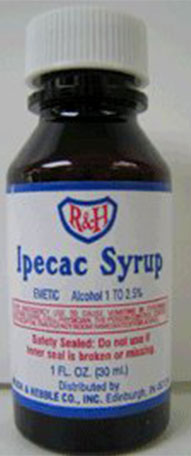Moms: Throw Out Your Ipecac!
By Chris Williams on October 9, 2014.

An example of an Ipecac Syrup bottle bought in the past.
When I was young, every conscientious mom had a small bottle of syrup of ipecac in the medicine cabinet. The over-the-counter emetic has been used since the 1950’s as an antidote for accidental poisoning. Taking a dose of the stuff induced vomiting. Within 30 minutes, the child threw up whatever he had swallowed that was potentially dangerous, in effect getting it out of his system.
Even as recently as 1983, The American Academy of Pediatrics recommended that every household have a 1-ounce bottle of syrup of ipecac available but that it be used only on the advice of a physician, emergency department, or poison control center. The ipecac was administered to the child in an attempt to start the stomach emptying process as soon as possible, before transport to the hospital, if needed. Sometimes, mom administered the ipecac and the poison control center would check back by phone to monitor the child’s progress.
Ipecac Syrup Loses Favor With Pediatricians
In 2003, the American Academy of Pediatrics reversed its earlier recommendation and stated that ipecac syrup should not be used as a home treatment in a child who has ingested any toxic substance. The policy statement also recommended that any ipecac currently in homes should be disposed of safely. Most people aren’t aware of this new thinking and ipecac syrup is still sold for this use in drug stores.
It’s not that the stuff doesn’t work. Ipecac causes vomiting in most people and helps prevent the absorption of toxins in the intestine. However, ipecac was widely accepted and recommended without any real studies of its overall usefulness. Studies have now found that the adverse effects and problems from ipecac use do not outweigh any benefits. Further, there is no evidence from clinical studies that ipecac improves the outcome of poisoned patients. Its use in the home did not decrease the number of visits to the emergency room. New recommendations are that ipecac should only be used in certain rare circumstances, and then only as directed by medical personnel. It is no longer recommended for routine use in homes or in the emergency room.
There has been a general move away from treating accidental poisoning with gastric emptying practices like induced vomiting. With some types of corrosive chemicals like toilet bowl cleaners, ammonia, and certain pesticides, vomiting can cause even more burn damage to the throat and mouth as the caustic material comes back up, or if it is inhaled into the lungs during vomiting.
First Response? Call Your Poison Control Center
Whenever a child, or anyone, swallows a potentially poisonous substance, your first course of action should be to phone the Poison Control Center for guidance (Phone 1-800-222-1222 to be connected to your local Poison Control Center). Their experts know the proper treatment for each dangerous chemical and will talk you through the steps you need to take. For information on poisoning from pesticides, The National Pesticide Information Center (NPIC) at 1-800-858-7378 can guide you as well.
For additional information on accidental poisoning from pesticides or other chemicals, see the following: